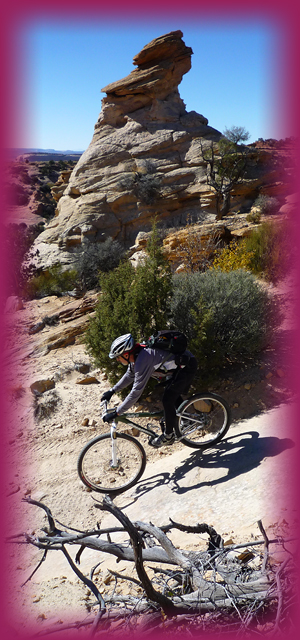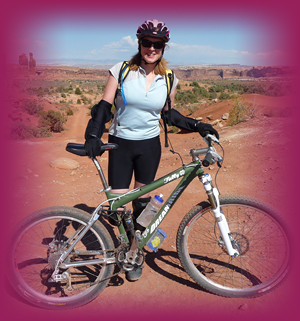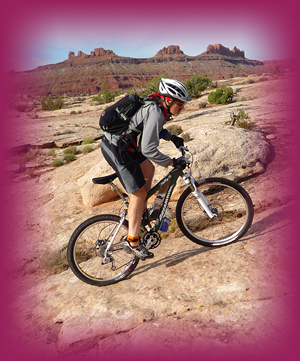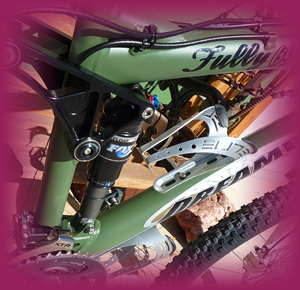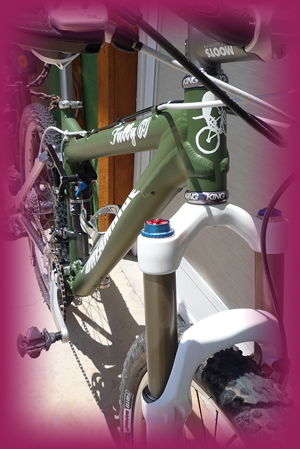
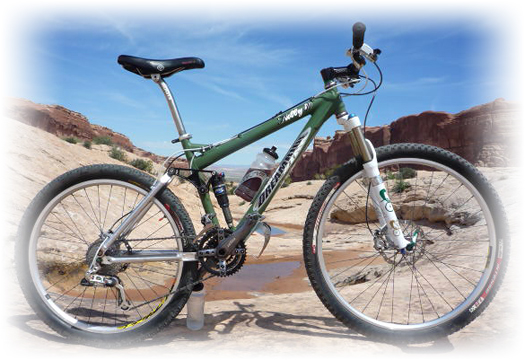
THE BIKE THAT KEEPS THE OLD MAN IN FRONT OF THE PACK
New fork
Less weight
New Custom Paint
Evaluation from 2009-2010
INFLUENCES OF THE DREAMRIDE WHITE RIM 69ER
FORKS FOR 2009
We never waivered from pushing the long travel "cross country" idea, even when others were looking at us funny. By "cross country" I mean "quick." I don't mean cross country racing, because race courses are generally smooth. We tried combos up up to 9 inches and settled on 6 inches of rear travel combined with a fork that allows us to change front travel on-the-fly from five to seven inches (26 inch wheels). It has always been about producing a bike that is, first-of-all, EFFICIENT! This means that any Fully takes far less energy to ride over rough trail than other bikes. I am frankly surprised by the power of magazine marketing's ability to convince people to buy obsolete, cheaply made, and poorly designed bikes. People still buy anodized frames though they are not as strong or as environmentally responsible as powdercoated frames (see more on anodizing processes below).
And our bikes are custom built to include the best components, matched to the frame and balance with each other in strength and efficiency. ALL our components require absolute minimal maintenance and can take the abuse an avid rider can dole out. To this end every part, every detail of the Fully has been tested in the real rough world of Moab, Utah, under professional riders.
Most of all, our bikes must be inspirational, with classic elegance, and the finest craftsmanship we can provide. We do not compete by paying for marketing. We compete in the true performance realm. This means that you look at our bike and simply want to get on it and RIDE! Then it returns your expectations to you with a bonus. It has SOUL! We chose the absolute best fabrication facility in the world to build and help us design the Fully frame (Gibson Design Group, the parent company of Ventana), so the construction is as good as it gets in the field of handmade aluminum bicycle engineering.
Since the Fully is built to be the very best bike we offer (and we only offer the best of the best, as you can see), we want to satisfy needs within a range of prices and specific uses, so we diversify parts selections into three categories. This is done to more perfectly suit riders' needs with balanced parts kits for riders from 5' to 6'8" and a range of rider weights up to 265. A Fully can now be very light for racing (always calculated for a specific rider weight and height) or built for the long haul over rough terrain. We reached into our tested SuperEgo and MRC kits to offer somewhat less expensive versions with no compromises in performance. You may see weights go up as the price decreases, but minimally.
WARRANTY
FINISH
The MAX kit, originally designed for the Moots Smoothie, soon found its way onto every other Moots mountain bike we sell. Now, MAX parts are the foundation for the ClimbMAX kit, the steroid version suitable to our Fullies. The MAX kit, in its pure form with lightweight wheelset and complete compliment of titanium goodies, is sometimes used for smaller riders or anyone who wants to use the bike almost exclusively in mountains at elevation. In 2005 we started mating the MAX with the XDT kit for All Mountain use, and that is where the ClimbMAX came from. The titanium parts cancel out weight of the more stout wheelset of an All Mountain wheelset with 20mm front axle and solid rear axle.
Mutant HD is basically an XDreamTrail parts kit with a beefed-up Fully frame to match. This can be an all mountain to light freeride version of the Fully or a solid XC platform for a very large rider.
SuperEgo parts use Thomsom seatpost and stem and some XT-level parts, sacrificing grams in weight for a substantially lower price. Nothing at all wrong with those XT parts, by the way. Some consider them superior to XTR.
SuperEgo MRC kit mods involve the posibility of custom downgrades in hubs (to Hugi or Shimano), cranks (to XT or FSA Afterburner), drivetrain (to X.9 or XT), and dampers (to Fox Float) to lower cost. The Serfas composite shipping case can be downgraded to a reuseable cardboard case or we can ship the bike to you in a loaner hardshell flight case. MRC is used to get the price down without sacrificing performance, though there may be as much as a two pound weight gain and some loss of suspension tuning. Do NOT ask for an estimate. Simply state your designated price within reason and if we cannot get there we will tell you right away and tell you just how we will do it.
Update on Fox DHX-Air Rear Shock
Updated July 2010 ~ New developments: New fork. Less weight. Custom paint jobs.
This is the latest entry into a journal that has been mostly ignored as the bike that it is about is all but ignored. The F-69 is the only mountain bike I have been interested in riding over the past year and some. The reason is simple: It has been such an advantage on the trail that I simply cannot do without it. It keeps me ahead of the gonzos and has such stable and intuitive handling that it has become a necessity. I am addicted to the advantage and the feeling of safety between those two wheel sizes . I have had many clients and other guides ride with me since I have been on the F-69. Many of these people are far stronger than me, younger by 20 to 30 years, and some are more skilled. I seem to have no problem leaving anyone behind when I want to, and sometimes I feel like I have to because the realm of speed in which the F-69 operates with the most efficiency is a few miles per hour faster than I normally ride. It wants you to get it up to a point where the front wheel is hardly contacting the bottoms of any ruts or gaps or distances between rocks.
The Fox Talas RLC 9er fork with 15mm thru-axle has taken care of the ONLY negative I have encountered with the F-69 over the past year---a consistent loosening of skewers, front and rear, especially on the front axle. I ride Moab and that is all I do, and, as they say, the trails are fast and bumpy to the extreme. I have been practicing a ritual to save myself a visit to the emergency room--stopping at the bottom of every long rough section of trail to check and tighten my skewers. There were a few times when I could open them up with only flick of my finger. This is a very scary feature of 9er forks, especially the longer ones at 120mm of travel. There is so much flex in these long forks (and Fox is the most rigid I could find!) that the dropouts are moving laterally with bump forces. You hardly notice when the speeds go over 25 miles per hour due to the incredible inertia of the big wheel and tire up front, but the axle knows. When the 2011 Fox Talas RLC 29er with 15mm axle fork was released a month or so ago I bought one instantly, pleading with our Fox rep to get it to me as soon as possible before I broke my neck. The cream on top of this new development is that the Talas has the very best features of any 9er fork to date. Tuneable rebound, slow speed bump valving, lockout and adjustable travel. You can lock out the fork at 120mm or at 95mm, which, in combination with the RP-23 rear shock's tuneable lockout ProPedal valving, creates more ride-from-town and mountain singletrack abilities. Now I can lower the front end for long stretches of uphill and lock out the bike when on pavement or smooth dirt. This has given the F-69 more capabilities as an all-around mountain bike.
Over the past year and more I have put the F-69 through a torture test. Shortly after I worked out the geometry and the 26-29 format for the newest version of the Fully, Sherwood Gibson of Ventana, who builds our Dreamride bikes, asked about the performance of the F-69 and I had to share with him the great success it has been in the performance department, if not in the sales department. I understand that people think the F-69 looks weird with its two wheel sizes, HD fat tubes and downward sloping stem, even in the face of the motorcycle industry's total commitment to the "large front rim small tire and small rear rim with fat tire" aesthetic. The public is slow to change its mind from carbon fiber bikes that weigh 22 pounds and break in a year or two. There are more consumers out there than mountain bikers, but I am still building for the mountain bikers. Let the marketing hounds have the consumers and their repeated bike purchases, chasing the dream of having the "dream bike." The F-69 is simply a better bike. From my review of the F-69 Ventana immediately began selling the El Chucho (Sherwood is fast at production! and that is why we love working with him). His version of the 69er is a bit more slack, lower and a tad lighter. The original F-69s had a 2" straight gauge downtube and a 1.75" top tube. The reason I spec'd these honking tubes on the first few frames was rigidity and predictable handing at speed--plus I had no idea of just how much the frame could take of that 9er front wheel's abilities. The HD tubes worked like a charm, adding less than a pound to the overall package. For Moab, for repeated runs on Porcupine Rim, for all the many stupid-bumpy trails and especially for sections of trail that allow extreme speeds up to 50mph, the fat tubes are totally necessary (as is that thru-axle front fork). Despite the awesome solid feel of the HD-tubed F-69, I am spec'ing the same tubes as the Chucho as standard equipment to lighten the bike and make it look a bit more svelt, and more XC-racy. You can opt for the HD option or the under-downtube cables, but the steeper head angle and slightly higher bb remain. I do not like a headangle of less than 70 degrees on a 9er. 9ers with slacker angles than 70 degrees get to the top of a rise and the wheel flops over when it stops rotating. Of course, the adjustable travel option on the Talas can turn a 69 degree headangle into a 71, so its apples and oranges again. Get either version, the F-69 or the Chucho and you will be happy by adjusting your riding habits to the performance windows of both bikes. The F-69 will more readily pedal over rocks and roots without whacking a pedal. The Chucho will feel a bit more stable when you are not pedaling by virtue of its lower bb.
Another way to loose weight is in the wheelset, so I am offering a SuperLite wheelset and tire combo. It has a weight limit of 175 pounds, but looses about two pound of weight off of the entire package.
For those of you who want the cables under the top tube, lower bb and a slacker head angle, the Ventana El Chucho is the only alternative to the F-69. If you want a Chucho, the price and the parts specs are the same as the F-69, except in one regard, custom paint.
I am a painter. Been one since I was a kid. I majored in painting and got my first BFA degree in fine art painting. Lately I have been painting road bike frames. I don't really think putting a really fancy custom paint job on an aluminum frame is such a great idea for someone who is going to beat it to pieces, but for that special sort of person who wants something extremely rare and interesting, I have decided to paint a few of the F-69s. You can get an idea of the work I do by visiting CUSTOM PAINT. I will be doing two separate two-color schemes on the F-69 for $750 in addition to the cost of the bike. Each paint job is hand painted and totally unique. Custom painting slows down the ordering process, so be aware that you will be waiting upwards of 3 months for a custom paint job. The F-69 generally in stock or solid colors generally gets to you in less than a month.
"Did that bike slide at all in that loose stuff?"
"No, I could turn at will, even over the thumb-sized sandstone rubble."
What we have here is the best of both worlds, what has turned out to be the best performing mountain bike we have ever offered. The 26 inch rear wheel gives us accurate gearing. The 5" travel front 29er front end rolls over obstacles and debri, yet is still capable of accurate steering control over loose ground. The six inch travel rear suspension hooks-up like velcro to propell the front wheel up and over ledges.
You won't be reading about the F-29 in the magazines, most likely. We don't advertise and have found that if you don't pony up, they are not interested in your product, even if it is a benchmark of sorts. The fact remains that in this place where mountain bikes really show their strengths and weaknesses, the Fully69 (F-69) is as good as it gets. It is here right now. You can have one.
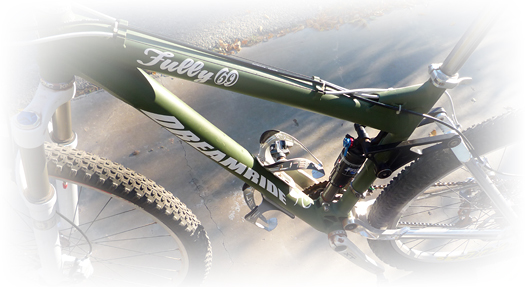 "This could be the ultimate mountain bike." As anyone who rides in mixed company (26 inch wheeled bikes and 9ers) already knows, advantages of the smaller rear wheel have to do with acceleration, quick handling and climbing steep grades. Advantages of the 29 inch wheel have to do with rolling momentum and lesser impact over moderate trail obstacles. While we have been experimenting with 29 inch wheels, development of our White Rim 69er hardtail more than confirmed the advantages of using the both sizes in one package.
"This could be the ultimate mountain bike." As anyone who rides in mixed company (26 inch wheeled bikes and 9ers) already knows, advantages of the smaller rear wheel have to do with acceleration, quick handling and climbing steep grades. Advantages of the 29 inch wheel have to do with rolling momentum and lesser impact over moderate trail obstacles. While we have been experimenting with 29 inch wheels, development of our White Rim 69er hardtail more than confirmed the advantages of using the both sizes in one package.
The idea of the F-29 design came from our White Rim 69er, a fully rigid hardtail titanium 69er that emerged after three years of testing 29 inch wheel prototypes.
The rigid White Rim 69er ti hardtail works like a charm, despite lack of any suspension squish aside from 2.55 baloon tires. It has been a joy to ride the WR-69 because of its simplicity and efficiency. It echoes a spirit I felt in the mid to late 80's when suspension parts were not available, but very light frames were starting to happen at a prices below $2K. The slack angles and long chainstays of the WR-69 create compliance that takes the edge off of most rough stuff. It was designed to be compliant, but this IS Moab and suspension is very welcome indeed. The WR proved that the 69 format was so good that you could actually do without suspension and still ride the rough stuff without beating yourself to a pulp.
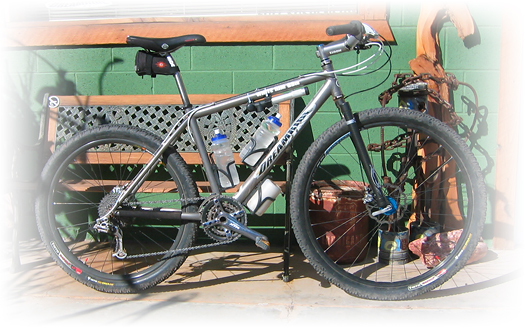 The only obstacles I ever encountered on the WR-69 that made me wish for suspension were long stretches of babyheads and deep perpendicular ruts in sandy Jeep trails caused by water erosion. The On One Mary Bar originally on White Rim 69ers is an ergonomic adjustment to further deal with the lack of front suspension. The angle at the wrist helps with control over very rough ground and is far more comfortable and easy on the wrist. The angle of the Mary Bar is the reason we now have 12 and 14 degree custom Moots bars built. The White Rim is still available. In 2008 we used the custom bars on Moots custom 69ers we had made to our specs. Now, Moots is offering the Gristle 69er in rigid, YBB and with 4 inches of travel for 2009, and the custom bars work like charm on all models.
The only obstacles I ever encountered on the WR-69 that made me wish for suspension were long stretches of babyheads and deep perpendicular ruts in sandy Jeep trails caused by water erosion. The On One Mary Bar originally on White Rim 69ers is an ergonomic adjustment to further deal with the lack of front suspension. The angle at the wrist helps with control over very rough ground and is far more comfortable and easy on the wrist. The angle of the Mary Bar is the reason we now have 12 and 14 degree custom Moots bars built. The White Rim is still available. In 2008 we used the custom bars on Moots custom 69ers we had made to our specs. Now, Moots is offering the Gristle 69er in rigid, YBB and with 4 inches of travel for 2009, and the custom bars work like charm on all models.
Our White Rim is now built by Lynskey, founders of Litespeed, so you can have a completely rigid ti 69er that inspired the F-69. The White Rim 69er dictated the geometry of the F-69. If you sit on an F-69, sagging it into the sweet spot, you get a White Rim 69er with squish. The idea turned out much better than expected! The F-69 IS truly the ultimate mountain bike! Over rough terrain this is the best handling mountain bike we have ever offered, more technically capable at speed than any bike in the enduro/all mountain class. It leaves the best 29ers in the dust anywhere the trail starts to go up in the rough or anywhere you stomp on the pedals to gain speed for obstacles or upcoming hills. Nowhere is this combination of 26 and 29 inch wheels more rewarding than on a Moab singletrack.
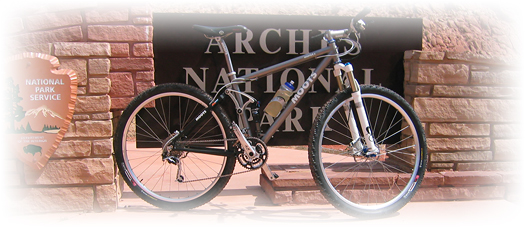 A SHORT COMPARISON TO THE MOOTS XZ
A SHORT COMPARISON TO THE MOOTS XZ
If you ride smooth to moderately rough trails, we offer the best full suspension 29er on the market, the Moots Mooto-Xz, but I can honestly tell you, because I own both, that the Fully69 leaves the Xz in its dust when trails are technical and/or speeds go up. The Moots is a finess machine. It kills the F-69 when it comes to long distance spins and flat to rolling ground. But when the terrain starts to get funky, the F-69 just cuts through, no matter what. The Moots is flexy and twitchy by comparison. The Xz is best built light and right for racing or long distance rides. If you are a roadie, you will love the Xz as your sole mountain bike. It gets the job done nicely, but with a lot more attention to your line. Where the Xz shines is Rides From Town or rides that need you to travel on roads of any kind for longer distances! If I didn't have a car, I could make do with Moots Xz. On pavement, locked out front and rear, the Xz is a totally cush road tourer when you run a smaller smooth-bellied tire. Run a 14 degree bar, put your head down, keep the spin round and the body sleak. When you get to the trail, it does everything well except those huge side loads of really rough downhill, hard slickrock mogul impacts and fast turns, which it does better than most mountain bikes on the market, anyway. It just cannot equal the lateral rigidity or acceleration abilities of the F-69!
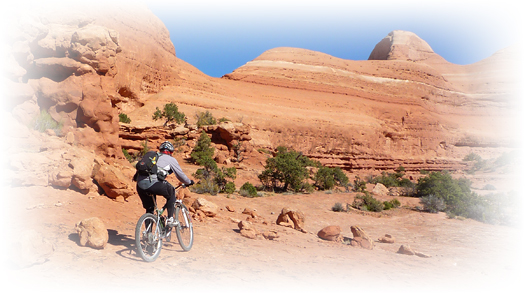 After riding the Xz, the F-69 feels a bit strange, but it only takes a heartbeat to get the hang of the position and geometry when you hit the trail. The more "point and shoot" geometry is familiar to downhillers and freeriders, but it is not what you might expect. It might feel slack the first time you get on it or as you impact abstacles, but getting the bike to turn never feels slow. The 70.3 degree head angle feels slack because of the rake of the fork in combination to the larger contact patch of the front wheel. Cross country riders should simply learn to relax and trust the bike to do more than they expected it to. Just ride--attack the hills and glide down fast with more control. You will find loose rocks, gravel, off-camber stuff with snot on it, and slickrock walls that looks to steep to roll up without throwing the front wheel on it first---well they all get a lot easier. This bike effortlessly goes over things and down things that we used to have to worry about.
After riding the Xz, the F-69 feels a bit strange, but it only takes a heartbeat to get the hang of the position and geometry when you hit the trail. The more "point and shoot" geometry is familiar to downhillers and freeriders, but it is not what you might expect. It might feel slack the first time you get on it or as you impact abstacles, but getting the bike to turn never feels slow. The 70.3 degree head angle feels slack because of the rake of the fork in combination to the larger contact patch of the front wheel. Cross country riders should simply learn to relax and trust the bike to do more than they expected it to. Just ride--attack the hills and glide down fast with more control. You will find loose rocks, gravel, off-camber stuff with snot on it, and slickrock walls that looks to steep to roll up without throwing the front wheel on it first---well they all get a lot easier. This bike effortlessly goes over things and down things that we used to have to worry about.
You, yourself, don't have to be twitchy, because the bike is not twitchy, but it can surely change directions fast if you want it to. It is rock solid on the straights and in tight trail situations. The combo of 26/29 long travel is never so welcome when the trail starts to get really bumpy. I have never felt safer behind the front wheel of a mountain bike than on the F-69. This is where you save energy.
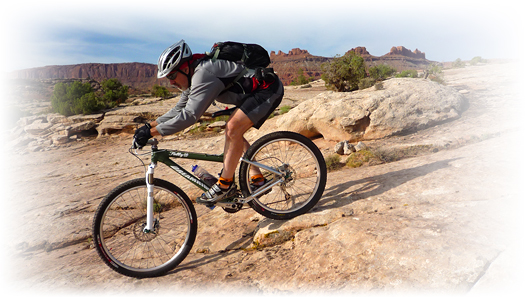 At slow speeds you just point it, lean or counter-hip-lean to avoid limbs or to make tighter turns. It goes where you want to go and it goes there, rolling over just about anything you point it at. Just stay over the center of the bike in relation to gravity, lift your ass off the saddle a bit, stay loose, and it rolls over high curb-sized rocks and ledges all by itself. Shift your weight back a bit, push down on a pedal and the front end lofts with ease, erasing the obstacle for the front wheel. Lean forward on climbs and compress the fork and it turns like it is on a rail over obstacles. The rear's fat tire and 6" of travel does the rest. This is what the Fully69 is designed to do: Save energy over rough terrain by making things that used to be hard, easy.
At slow speeds you just point it, lean or counter-hip-lean to avoid limbs or to make tighter turns. It goes where you want to go and it goes there, rolling over just about anything you point it at. Just stay over the center of the bike in relation to gravity, lift your ass off the saddle a bit, stay loose, and it rolls over high curb-sized rocks and ledges all by itself. Shift your weight back a bit, push down on a pedal and the front end lofts with ease, erasing the obstacle for the front wheel. Lean forward on climbs and compress the fork and it turns like it is on a rail over obstacles. The rear's fat tire and 6" of travel does the rest. This is what the Fully69 is designed to do: Save energy over rough terrain by making things that used to be hard, easy.
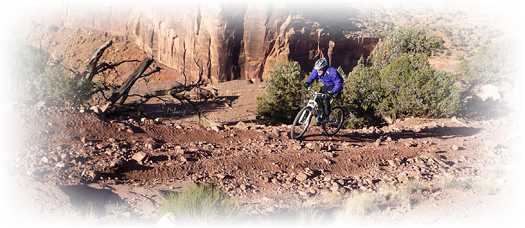 The combination of the big front wheel, stout frame front triangle, laterally rock solid 4 bar rear end from Ventana, and the long travel suspension parts make the Fully69 capable of serious control at speed over loose ground and in any situation where obstacles come at you fast. The front end geometry along with a rearward weight bias of the overall package mean that you can flick the bike around when you are going fast. Instant changes in direction happen without shakiness or wobble. The huge gyroscope of the front wheel keeps the package on track. Get behind that front wheel and you are relatively safe at high speeds.
The combination of the big front wheel, stout frame front triangle, laterally rock solid 4 bar rear end from Ventana, and the long travel suspension parts make the Fully69 capable of serious control at speed over loose ground and in any situation where obstacles come at you fast. The front end geometry along with a rearward weight bias of the overall package mean that you can flick the bike around when you are going fast. Instant changes in direction happen without shakiness or wobble. The huge gyroscope of the front wheel keeps the package on track. Get behind that front wheel and you are relatively safe at high speeds.
One performance aspect of the 69er that is particularly beneficial is the way the bike allows for more stable pedaling out of the saddle at high speed. The increased rolling weight of the front wheel causes the front of the bike to be extremely stable at speed. This gyroscopic effect allows the rider to put more torque into the handlebars without causing the bike to veer. To feel this effect, shift up a couple of gears and stand up as you enter an uphill grade at speed. Lean into the handlebar and torque the pedals to accelerate. It is easy to feel the difference. The front wheel keeps the handlebar rock solid under torque loads as the smaller rear wheel allows quick acceleration up the hill. I have found this to be a huge advantage. It not only helps you go faster, the technique is less stressful on our upper body as the front end requires little or no correction for torque into the bar. It is an amazing feeling, actually, like having a solidly mounted bar to use as a torque platform. More energy goes into the pedals. I notice that I ride away from stronger riders on dirt road rollies by virtue of this advantage that only the 6-9 combo can provide.
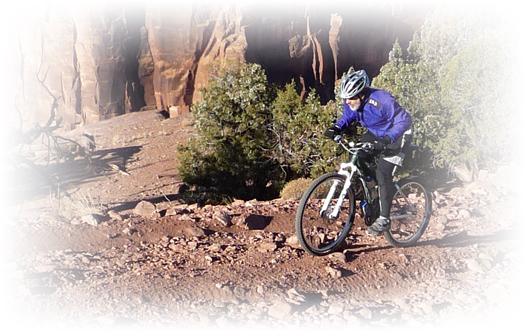 Our philosophy over the past twelve years has been towards long travel cross country. The handling advantages of long travel (not too long, by the way--we have found 6" of travel to be just right) are based on the ability to change the geometry with weight shifts fore and aft through the use of variable suspension sag. This means a bike with slack geometry (measured when the bike is flat on the ground without a rider aboard) gets steep and quick by simply removing weight from the rear wheel, compressing the front suspension. Get off the saddle, bend your knees and lean forward and the bike becomes far quicker. Subtle weight shifts allow the bike to climb or descend at a variety of speeds without fear or wasted energy.
Our philosophy over the past twelve years has been towards long travel cross country. The handling advantages of long travel (not too long, by the way--we have found 6" of travel to be just right) are based on the ability to change the geometry with weight shifts fore and aft through the use of variable suspension sag. This means a bike with slack geometry (measured when the bike is flat on the ground without a rider aboard) gets steep and quick by simply removing weight from the rear wheel, compressing the front suspension. Get off the saddle, bend your knees and lean forward and the bike becomes far quicker. Subtle weight shifts allow the bike to climb or descend at a variety of speeds without fear or wasted energy.
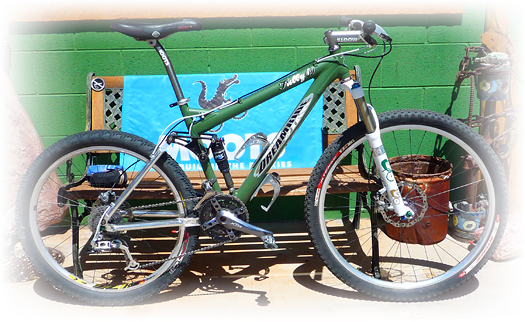 The most shocking aspect of the F-69's performance is climbing over steep repeated ledges, roots, sand, gravel, loose rocks and/or debris. It simply eats up technical climbs no matter what the trail is like. The tight rear end pushes the front hoop over boulders and ledges for the best combination of acceleration and roll-ability over obstacles I have experienced. Rough sections of the Sovereign Trail that used to be physically and technically challenging are now just climbs--as long as I am aggressive. That is the operative word. Without "aggression" the stout frame and long travel are just things to haul up a hill to make you go down faster. This is true of all bikes I design. Their handling traits are best enjoyed by a fit experienced biker, but can save the life of a lesser skilled rider. When ridden with timed aggression, you use less energy on the complete ride. It can cruise with the best of them, but it can also leave the best of them behind when there is a rider aboard in tune with the efficiency curve of a Dreamride bike.
The most shocking aspect of the F-69's performance is climbing over steep repeated ledges, roots, sand, gravel, loose rocks and/or debris. It simply eats up technical climbs no matter what the trail is like. The tight rear end pushes the front hoop over boulders and ledges for the best combination of acceleration and roll-ability over obstacles I have experienced. Rough sections of the Sovereign Trail that used to be physically and technically challenging are now just climbs--as long as I am aggressive. That is the operative word. Without "aggression" the stout frame and long travel are just things to haul up a hill to make you go down faster. This is true of all bikes I design. Their handling traits are best enjoyed by a fit experienced biker, but can save the life of a lesser skilled rider. When ridden with timed aggression, you use less energy on the complete ride. It can cruise with the best of them, but it can also leave the best of them behind when there is a rider aboard in tune with the efficiency curve of a Dreamride bike.
In sand, the Fully69 is simply a monster. There is a point of speed when riding a bike over soft sand where the tires ride out of the rut and begin to float. This is where the bike can accelerate radically to higher speeds. It is a pleasing phenomenon available only to those who understand the technique, are willing to invest the energy, and have a bike that can accomplish it. If you take advantage of the moment of acceleration by grabbing a higher gear and maintaining power output evenly, you can travel at ridiculously high speed over soft sand, as long as you stay on the power. It helps to have at least one section of the sand that is slightly downhill, but the technique is available as long as you can gain the speed necessary. The Fully69 is the best bike ever at reaching and maintaining speed over deep sand and medium sized obstacles, so much so that anyone riding with me on a 26 inch wheeled bike is left far behind in those conditions. I have been riding sand since I was a kid, but my sand skills simply allow me to understand what is possible. They don't erase my age. My skills, fitness and knowledge cannot account for the radical high speed I gain over other bikes when pedaling on the F-69--it is simply due to the equipment. The long sand stretch on the old Monitor and Merrimac Trail has become a place of amusement, not dread. It is shocking to be going so fast over such a soft surface! I look forward to it.
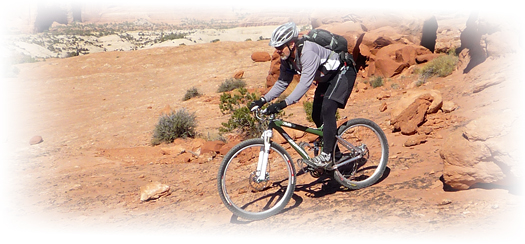 The Fully69 was never intended as a replacement for the Fully26, but I must say that it has for me. I recommend the 69 version over the 26 for all but the smallest, most aggressive or heaviest riders. Jumpers will want to go with the F-26 Mutant. While geometries are different, handling traits of the models remain very similar--by design. The only real difference in performance of the F-69 comes from the fact that I have lowered the bottom bracket height from the original Fully (14" as compared to the 14.4" on the Fully) to make it a bit friendlier on tight, steep mountain singletrack. This makes steep descents feel a bit less tipsy. It also better facilitates weight-shift turns by making them easier to initiate.
The Fully69 was never intended as a replacement for the Fully26, but I must say that it has for me. I recommend the 69 version over the 26 for all but the smallest, most aggressive or heaviest riders. Jumpers will want to go with the F-26 Mutant. While geometries are different, handling traits of the models remain very similar--by design. The only real difference in performance of the F-69 comes from the fact that I have lowered the bottom bracket height from the original Fully (14" as compared to the 14.4" on the Fully) to make it a bit friendlier on tight, steep mountain singletrack. This makes steep descents feel a bit less tipsy. It also better facilitates weight-shift turns by making them easier to initiate.
The head angle of the Fully69 is 70.3 degrees, finely tuned to combine with the long rake of the Fox fork to provide a wonderful balance of stability and quick handling--at a walk or AT SPEED. Tire changes allow you to tune angles a bit. When you are climbing into tall ledges formed by large root systems, you need not fear rolling into it even with a 2.0 tire up front. Only a slight weight shift, unweighting the front while moving the body forward, followed by a push on the bars to help the rear wheel over, will get you up and over large ledges smoothly. Yes, it takes strength, but the bike will do more than you think. The long travel Ventana 4-bar rear end follows you wherever you go, helping the rear wheel grab as it rebounds off the roots.
The smallest Fully69 for riders as short as 5'6" (pictured on the Fully sales page at the top) has a 23 or 23.3 top tube (depending on the rider). The longer tube works well in combination with Dreamride custom Moots-made 12 or 14 degree sweep bars made especially for this frame. The longer tt serves to eliminate toe overlap, making it possible for smaller riders to take advantage of the larger front wheel. The expanded size range is a welcome feature on the F-69. The F-69 has no weight limit, something I cannot say about 29ers we offer. And for those who are truly small, we can drop the front wheel down to 27 inches to offer the same performance advantages riders above 5'6" enjoy with the 69.
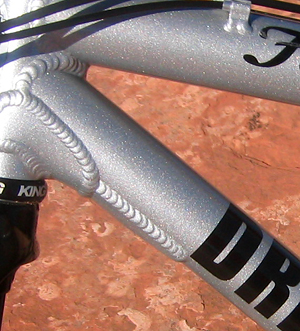 The Fully Models of 2009
The Fully Models of 2009
All 2009 Fully models, in 26 or 69, have received redesigned headtube gussets to accommodate wider forks (thank you, Sherwood). Geometry on the 26ers remains unchanged, though compensated for longer travel up front. Our primary fork choices for the F-26 are the Magura Thor or Wotan, the two best suspension forks at this range of travel. Marzocchi is still there for those who prefer their expanded fine tuning features, or we can substitute a Fox, but Magura is the sleeper fork with smart German engineering and manufacture. You don't see raves in the magazines over these forks for the same reason you don't see Dreamride bikes mentioned--Magura's U.S. distributor has a minimal advertising budget. But, they are still the best, even if I am the only one out here in the real world tooting their horn. Try one. You'll see what I mean. Work on one and you will certainly be happier than slogging through the oil baths and complicated valving parts of other designs. The Magura is easily rebuilt.
Magura forks are based on a cartridge system that simplifies maintenance and increases reliability. They are incredibly stiff, amazingly plush, very light and beautiful, coming in black or white. Magura is working on a 29er fork this year. In the meantime, we are using a Fox F29-120 for the F-69, a very fine fork, though certainly overpriced for its tuning features. That said, it works like a charm on the F-69, perfectly matching the performance of the Fox RP-23 shock on the rear of the bike. We ARE looking forward to a stouter axle in the future, but I have few complaints about the fork's performance within the overall bike right now because there is nothing out there that competes with it.
The F-69 tends to loosen up front skewers when you spend a lot of time speeding over technical rock. I have learned to check skewers at least once or twice during a ride--especially after long fast sections over big bumps! The problem lessens as the fork breaks in and paint starts to groove up where the skewers tighten down on the dropouts, but it never really goes away. Best be safe and check tightness as a mode of operation! I have not heard much about this problem from others. My guess is that it is a Moab thing. Moab is truly the best testing location for mountain bike equipment because of the beating it doles out to the rider and his or her equipment.
For 2009 the Dreamride Fully comes in three models, the Fully, Fully Mutant HD, and the Fully69. The parts selections for '09 remain. We still use XTR and SRAM X.0 as basic drivetrain components, Magura brakes, King hubs and headsets, DT spokes, and Mavic rims. Moots titanium stems, posts and bars. Magura, Marzocchi or Fox forks to suit the build. FSA carbon parts spice things up, if the rider wants a bit more weight savings at no additional charge. Shimano XT, Thomsom stems and seatposts are always in stock for those who want to save money without any effect on performance aside from a slight weight penalty.
The Fully26 and Fully26 Mutant HD use the same geometry in the front triangle, but have distinct differences in performance due to changes in tubing size and componentry. The Mutant HD comes with larger frame tubing (the same straight gauge 2" downtube as the 69, only shorter) and more extensive gusseting in many strategic locations for larger and/or more aggressiver riders. It also comes with the option for a Magura Wotan fork, for those who are larger or much more aggessive in their riding style.
The standard Fully26 frame is for lighter, less aggressive riders, though it is still a very capable all mountain bike. We can specify two sizes of downtubes on the standard Fully to accommodate rider needs.
The F-69, with a 29 inch front wheel and 6" travel rear end with a beefy 26 inch wheel, has demonstrated that it is an effective compromise between the quick acceleration of the 26 inch wheel and smooth rolling momentum of the 29 inch wheel. It is not quite as snappy as the original Fully at slow speeds, but much snappier than any full 29 inch wheeled bike and far more capable than the 26 at just about everything else. THE 6-9 COMPROMISE WORKS!
The Fully Mutant HD in medium weighs in at 33 pounds. The Fully26 and Fully69 in the same size, 29 to 30 pounds. These weight figures are based on complete bikes with very fat tires, waterbottle cages and stainless steel Time ATAC pedals. We can bring weights down, but don't see many good reasons to do so. The strength of the bike offers performance advantages that a lighter bike cannot compete against, except on a very long, smooth climb. Everywhere else the extra strength and rigidity more metal brings is very welcome.
The Fully design has developed over a dozen years. There are always examples of current Fully bikes of each model in our shop and we offer free lodgings to anyone who wants to come to Moab for sizing or to pick up a Fully or a Moots bike. If you ride a medium sized frame, examples are here for anyone to try with an appointment.
I personally ride each Fully, choosing the model based on trail challenges. For me, the standard Fully26 is a fantastic all-around rig, flickable and solid, built to roll around over bumps and hop onto ledges. The F-69 is better at long distance rides with more variety of terrain, especially if you keep the speed up. It is an awesome rig for any trail with sand, rolling and ledgy hills and especially loose rubble. The F-69 is the best handler of the bunch by virtue of its ability to respond to rider input even in the most extreme loose terrain at moderate to high speed, or when picking your way through nasty rock gardens or root mazes--the 29 inch front wheel really grabs control and the fat rear tire and its long travel four bar linkage claws and tracks better than any bike I have tried. It gets this good review whenever its wheels are on the ground. The Fully26, on the other hand, especially the Mutant HD version, enjoys airtime and is best at acceleration and in very tight situations.
The way the F-69 tracks over uneven and loose trail surfaces is truly remarkable. It responds with a thought at speed, safe and predictable, yet is incredibly quick when you ask it to be. The Fully26 Mutant HD is my choice for the big stuff, slickrock surfing, downhill shuttles and anything that creates high speed over rough terrain. It is my favorite slickrock bike, though all three excel on Moab rock. Each has its limits, but the limits of the Fully Mutant HD are far beyond my own personal limits. I can push the F-69 hard on slickrock and the fork becomes the only liability. It is a bike that likes to keep its feet on the ground. The Fully26 is right in the middle of this range from freeride to cross country. It does it all and is remarkably balanced. Folks who try the Fully26 always fall in love with it, even in the cul de sac in front of our shop. It just feels right under you. It is light enough and the geometry steep enough for tight technical mountain singletrack, then it can morph into an all mountain bike that will jam the big slickrock with only adjustments made in the riding style of the rider.
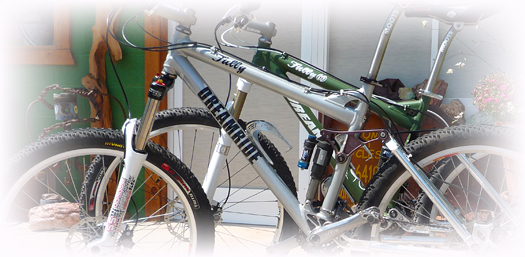 After prolonged riding I grew to love and depend on what the Fully69 is capable of, so I rarely reach for my other bikes on trails in Moab. I still contemplate the ability of the Marzocchi ATA55 and Magura Thor forks to take big hits and drops without getting twisty. The Fully26's fork choices allow changes in geometry on-the-fly by virtue of travel adjustment features, making the Fully26 very versatile in the mountains and on singletrack. The Magura and Marzocchi forks we use are so stiff and responsive on the Fully26 that you will not want to go back to a lesser fork--ever! If you are trying to decide on which version to get (dual26 or 69), go to FREQUENTLY ASKED QUESTIONS for more detail on differences. It is a simple decision in choosing the Mutant HD. If you are over 220 or ride really hard, if you like jumping and are over 175, the Mutant version is the one to get.
After prolonged riding I grew to love and depend on what the Fully69 is capable of, so I rarely reach for my other bikes on trails in Moab. I still contemplate the ability of the Marzocchi ATA55 and Magura Thor forks to take big hits and drops without getting twisty. The Fully26's fork choices allow changes in geometry on-the-fly by virtue of travel adjustment features, making the Fully26 very versatile in the mountains and on singletrack. The Magura and Marzocchi forks we use are so stiff and responsive on the Fully26 that you will not want to go back to a lesser fork--ever! If you are trying to decide on which version to get (dual26 or 69), go to FREQUENTLY ASKED QUESTIONS for more detail on differences. It is a simple decision in choosing the Mutant HD. If you are over 220 or ride really hard, if you like jumping and are over 175, the Mutant version is the one to get.
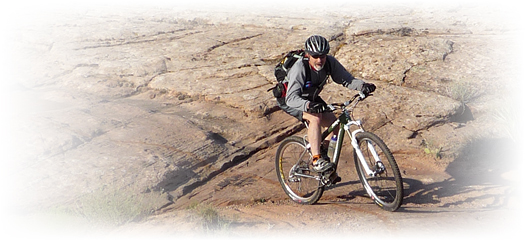
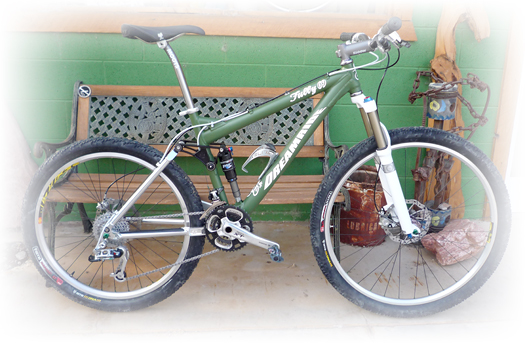
The frame is the heart of the bike, so it must be designed with a strong knowledge of the parts at hand. Every Fully is designed and built as a total package with frame sizing increments down to one quarter inch and all components proportionate and equal in strength. We manipulate parts to get the right bike for each client. We can alter fabrication of your frame to include details that best suit your personal needs. No one but Dreamride possess such a thorough knowledge of parts, parts combos and frame geometry. Why? Moab! We run a tour company. We ride. . . . And this designer's 50 years of off-road bicycling experience is pretty much unparalleled in the mountain bike realm. Moab puts bikes through the wringer. The Fully has been through many wash cycles, taken a beating and it has proven itself.
The Fully frame and parts hold up to trail and weather conditions that are unusually cruel. Sand and freezing rain are horrible elements for moving parts to survive. The entire rear section of the bike below was completely submerged in quicksand shortly after the picture was taken. Then it was dipped into a desert pot hole of muddy water to rinse it off. Then it was ridden all day. Back in the shop it was cleaned and put back on the trail for even more abuse during a driving freezing rain. Scroll down the page to see the bike along with another client's Fully on the car rack after the ride on Poison Spider Mesa in freezing rain. This is the abuse that the Fully can take and bounce back from. The Fully's parts were chosen because they are sealed and amazingly reliable, even in the face of nature's fury. Our cables are high to keep them out of the sand and mud. Our bottom brackets are high to keep you pedaling.
Each new Fully frame is guaranteed free of defects for two years from date of purchase. Aluminum does not last forever, folks, but we do our best to make it last for as long as possible. If you are looking for the lifetime bike, get a Moots complete titanium frame. If you are looking for a performance advantage over rough terrain, get the Dreamride Fully.
More words about finish: All Fully frames are powdercoated for a number of very important reasons. The first is environmental: Powdercoating eliminates toxic solvents and is safer for the worker. The second is integrity of the frame: If you think anodizing is the hip thing, you have fallen for marketing hype that basically makes your frame weaker, cheaper and disposable. Anodizing weakens welds, ruins tolerances and is basically impossible to redo without even further weakening and loss of tolerances. The reason manufacturers use the very environmentally destructive and worker-toxic anodizing process is simply because it is CHEAPER. An anodized finish costs less than half that of the powdercoat finish. The third reason is cosmetic. Paint looks better, can be touched up or redone, and it protects the frame better. Only through effective marketing can someone fall for the opposite idea. You've been had, if you own an anodized bike.
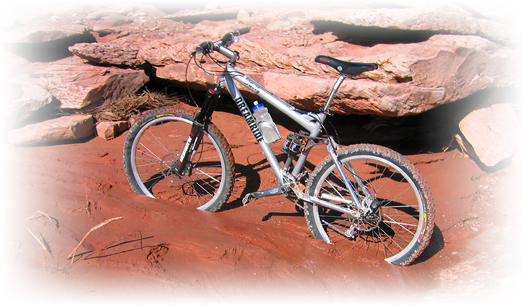 Parts like the new 2.25" stroke Fox air shocks, the Fox F29 and Magura forks have made it possible to run six inches of rear end travel with a balanced 5" or 6" front end for riders as small as 5'5". Riders under 5'5" may wish to go with 5" of travel with the same component options. We can go lighter on bars and wheelsets for lighter riders. We have built up Fullies to between between 26 and 33 pounds, depending on use and the client's physique, and can build them to as low as 24.5 pounds, which no one has convinced us to do so far. The overall geometry of each Fully puts the rider between the wheels and offers up a mixture of stable and quick handling qualities as the rider shifts weight fore and aft. The design of each personal bike takes into consideration dimensions and performance qualities of specific components, along with the body and performance demands of the client. We ALWAYS end up with a perfectly balanced mountain bike. Just ask Fully owners!
Parts like the new 2.25" stroke Fox air shocks, the Fox F29 and Magura forks have made it possible to run six inches of rear end travel with a balanced 5" or 6" front end for riders as small as 5'5". Riders under 5'5" may wish to go with 5" of travel with the same component options. We can go lighter on bars and wheelsets for lighter riders. We have built up Fullies to between between 26 and 33 pounds, depending on use and the client's physique, and can build them to as low as 24.5 pounds, which no one has convinced us to do so far. The overall geometry of each Fully puts the rider between the wheels and offers up a mixture of stable and quick handling qualities as the rider shifts weight fore and aft. The design of each personal bike takes into consideration dimensions and performance qualities of specific components, along with the body and performance demands of the client. We ALWAYS end up with a perfectly balanced mountain bike. Just ask Fully owners!
The Fully is not particularly radical in overall design. We don't want too much carbon fiber and think custom extruded liquid-shaped tubing that some manufacturers use is just a poor fashion statement, rarely is it anything more than a cost saving venture. Neither of these two fabrication methods make their bikes more rigid or better handling than the traditional triangle on the Fully. A triangle is still the stongest form and a tube still the most efficient frame member--remember your geometry classes in high school? The Fully is simply the best PROVEN example of a full suspension off-road bicycle at this point in time. Watching a rider on a Fully will tell you just how efficient it is. It sticks to the trail and flies over loose rocks on a whim. IT ACCELERATES OVER ROCKS, SAND OR BIG ROOTS WITH UNCANNY EFFICIENCY. It gets you out of situations that shock your brain and can get you INTO and OUT OF situations that are far beyond your personal skills, if you are not careful. If you are looking for a no-compromise high performance rig with refined handling qualities, and/or if you have unusual fit needs, the Fully is the only choice for those who do not compromise on quality or service. Go to DREAMRIDE FULLY for costs, modifications and cosmetics. 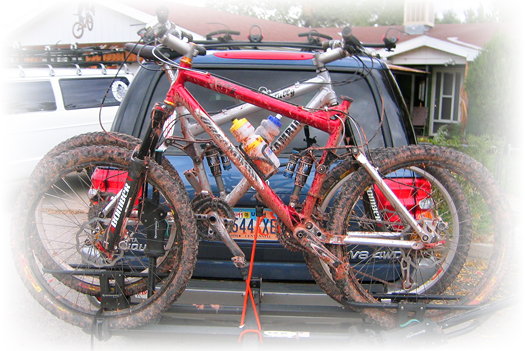 Sizing, Fit and Fully Parts Kits for 2009
Sizing, Fit and Fully Parts Kits for 2009
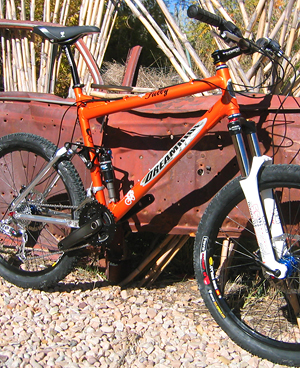 We are committed to making our own brand of Moab-tested full custom construction available to a wide range of riders, from those who want a true custom-fitted advantage for racing to those who want the ultimate all around mountain bike for every situation. Because the Fully is custom-fitted we attract larger and smaller riders outside of the range of stock frame sizing, looking for a long travel bike that fits them. But, that is only one reason to consider a Fully. Mountain bike fit is much overlooked in your local bike shop. They sell you what they have, not what you need. Even if you are in the midrange of fit, but have longer legs or shorter arms than usual, fit gets complicated. It is all about your body weight balanced between the wheels and the saddle and handlebar. Our shop is a bicyle STUDIO (see us in Bicycling magazine's list of best bike studios), not your run-of-the-mill shop manned by 20-something staff.
We are committed to making our own brand of Moab-tested full custom construction available to a wide range of riders, from those who want a true custom-fitted advantage for racing to those who want the ultimate all around mountain bike for every situation. Because the Fully is custom-fitted we attract larger and smaller riders outside of the range of stock frame sizing, looking for a long travel bike that fits them. But, that is only one reason to consider a Fully. Mountain bike fit is much overlooked in your local bike shop. They sell you what they have, not what you need. Even if you are in the midrange of fit, but have longer legs or shorter arms than usual, fit gets complicated. It is all about your body weight balanced between the wheels and the saddle and handlebar. Our shop is a bicyle STUDIO (see us in Bicycling magazine's list of best bike studios), not your run-of-the-mill shop manned by 20-something staff.
For 2009 we have three kits for the Fully: SuperEgo, our longtime standby; ClimbMAX, the absolute no-compromise cross country/ all mountain version; And the new Mutant HD for more agressive and/or larger riders. There is the opportunity to lower the price with subsitutions from another tested parts kits, the MRC, but cost of this bike mostly resides in the frame, fork and wheels which we refuse to compromise on due to their performance aspects and advantages.
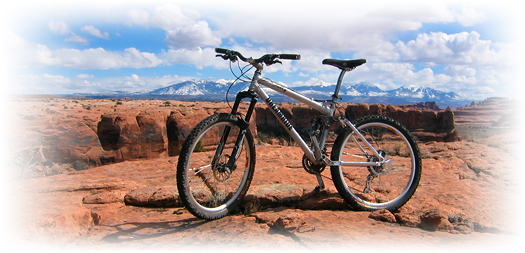 ClimbMAX is a direct result of building bikes for taller fellows who race cross country or live high in the mountains where the trails are tight and twisting and steep. It combines long travel with light weight titanium parts and cross country exotica. The ClimbMAX can also involve custom lightening the frame up to a half pound for pro racers, if, for you, the advantage in performance is worth the reduced structural life of the frame (you gotta race to understand). A complete ClimbMAX bike can be 26 pounds, even lower with narrow tires. A ClimbMAX Fully26 18" bike with a full 6" of travel front and rear with fat tires, wide rims and 7" brake rotors weighs 29 pounds. Pictured above are two ClimbMAX Fullies covered with trail grit.
ClimbMAX is a direct result of building bikes for taller fellows who race cross country or live high in the mountains where the trails are tight and twisting and steep. It combines long travel with light weight titanium parts and cross country exotica. The ClimbMAX can also involve custom lightening the frame up to a half pound for pro racers, if, for you, the advantage in performance is worth the reduced structural life of the frame (you gotta race to understand). A complete ClimbMAX bike can be 26 pounds, even lower with narrow tires. A ClimbMAX Fully26 18" bike with a full 6" of travel front and rear with fat tires, wide rims and 7" brake rotors weighs 29 pounds. Pictured above are two ClimbMAX Fullies covered with trail grit.
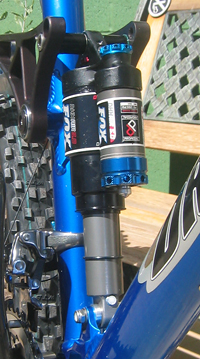 First, we cannot put a DHX on an F-29, so don't ask. After testing the Fox DHX-Air from its inception, this shock certainly makes the grade, but with one big reservation (keep reading). The good news is that you might expect the DHX-Air to feel like a air shock, but it doesn't. It takes big hits without blowing through midstroke and is plush, plush, plush. The ProPedal circuit really works and works extremely well, as on the DHX-5, only with a bit more pronounced effect. This was the first air shock to offer the stroke necessary for a full 6" of travel (the RP3, in late 2007, joined the 2.25" stroke party and now is on most Fullies that leave the shop). The DHX-Air is the first and only air shock to EVER get the juices flowing for more hardcore riders--it is a revelation---but it is not perfect! While it offers advantages in performance, it is not as reliable as it should be and should only be requested if you want and need those performance advantages and are willing to spend more time and money on maintenance. The bad-reliablity culprit is the seal between positive and negative spring chambers, which, when it fails, causes the shock to ride down into its mid stroke--you can get home, but only after stressing your frame and whacking pedals all the way. If the shock does not receive regular maintenance, it will fail on a ride, usually right at the onset of a day of use. I personally bought two DHX-Air shocks--with one as a back-up. The "Catch 22" of this situation has downgraded the DHX-Air to second choice for most riders--here it is: The DHX-Air fails in two situations: 1) If the shock is not regularly maintained, the seal fails. 2) If the shock is left to sit on a shelf, the seal dries out and fails in the first few minutes of use. This is a deal breaker for most people. If you love high performance, are into a tight maintenance schedule (it ain't easy to work on, by the way), you don't ride deep into wilderness where the failure of a rear shock could really ruin your day, and you regularly use the bike, the DHX is still the best. The DHX will not fit into the Fully69 frame due to the tight fit caused by the large downtube and the steep ascent it must make to reach that high headtube. If, like me, you don't like to work on the shock every 50 hours of use, the DHX is going to piss you off.
First, we cannot put a DHX on an F-29, so don't ask. After testing the Fox DHX-Air from its inception, this shock certainly makes the grade, but with one big reservation (keep reading). The good news is that you might expect the DHX-Air to feel like a air shock, but it doesn't. It takes big hits without blowing through midstroke and is plush, plush, plush. The ProPedal circuit really works and works extremely well, as on the DHX-5, only with a bit more pronounced effect. This was the first air shock to offer the stroke necessary for a full 6" of travel (the RP3, in late 2007, joined the 2.25" stroke party and now is on most Fullies that leave the shop). The DHX-Air is the first and only air shock to EVER get the juices flowing for more hardcore riders--it is a revelation---but it is not perfect! While it offers advantages in performance, it is not as reliable as it should be and should only be requested if you want and need those performance advantages and are willing to spend more time and money on maintenance. The bad-reliablity culprit is the seal between positive and negative spring chambers, which, when it fails, causes the shock to ride down into its mid stroke--you can get home, but only after stressing your frame and whacking pedals all the way. If the shock does not receive regular maintenance, it will fail on a ride, usually right at the onset of a day of use. I personally bought two DHX-Air shocks--with one as a back-up. The "Catch 22" of this situation has downgraded the DHX-Air to second choice for most riders--here it is: The DHX-Air fails in two situations: 1) If the shock is not regularly maintained, the seal fails. 2) If the shock is left to sit on a shelf, the seal dries out and fails in the first few minutes of use. This is a deal breaker for most people. If you love high performance, are into a tight maintenance schedule (it ain't easy to work on, by the way), you don't ride deep into wilderness where the failure of a rear shock could really ruin your day, and you regularly use the bike, the DHX is still the best. The DHX will not fit into the Fully69 frame due to the tight fit caused by the large downtube and the steep ascent it must make to reach that high headtube. If, like me, you don't like to work on the shock every 50 hours of use, the DHX is going to piss you off.
BUILT BY A SONGWRITER
Copyright Dreamride LLC. No material, written, graphics, or photographs on this website, may be reproduced, broadcast, published, re-written, re-edited, or re-used in any way outside of this site without written consent of Dreamride LLC and Lee Bridgers. Use of this site signifies agreement to terms of use.
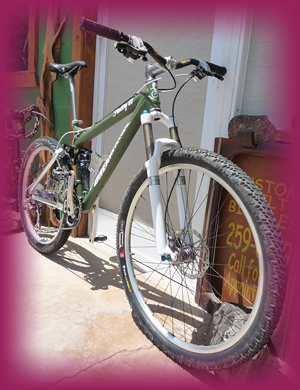 Our Current Fave!
Our Current Fave!
The Fully 69 has been the shocker of the year. After years working with the idea of combining 26 and 29 inch wheels, the Fully 69 brings the idea into the realm of Moab-style technical riding. This is the best performer in our stable, perfect for any rider from 5'7" and up. There is no weight limit on this bike!
